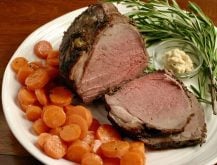Our niece Cathy is a working gal, who moved from her home town of Regina to Saskatoon. Cathy said she misses the Sunday night dinners with her parents.
To solve this, she and her friends now meet in their homes for dinner on Sunday night, taking turns cooking the meal. One rule is that they must serve a new recipe. They have
fun sharing successful and
unsuccessful dishes.
Recently we were invited to Cathy’s for dinner for some of the successes.
Read Also

Know what costs are involved in keeping crops in the bin
When you’re looking at full bins and rising calf prices, the human reflex is to hold on and hope for more. That’s not a plan. It’s a bet. Storage has a price tag.
Roasted red onions
3 large red onions, peeled and halved lengthwise
1/4 cup olive oil 60 mL
2 tablespoons 30 mL
balsamic vinegar
1/3 cup honey 75 mL
1/2 bunch fresh thyme
(or dried thyme, to taste)
salt and pepper, to taste
Preheat the oven to 375 F (190 C).
In a small bowl, whisk together the oil, vinegar, honey, thyme, salt and pepper until combined. Put the onions in a large bowl and pour the dressing over them. Toss everything together until the onions are well coated.
At this point you can marinate the onions for a few hours for more flavour or cook them right away. Put the onions on a baking sheet, cut side up, and bake for 40 minutes, until the onions are soft and slightly carmelized.
Serves four to six.
Source: Tyler Florence’s Real Kitchen by Tyler Florence.
Lemon melt-away shortbread
A friend brought these shortbread cookies to a tea in our town. I had to ask for the recipe. It’s a wonderful melt-in-your-mouth shortbread for lemon lovers.
11/4 cups 310 mL
all-purpose flour
1/2 cup 125 mL
cornstarch
1/3 cup icing 75 mL
sugar
3/4 cup butter, 175 mL
softened
1 teaspoon 5 mL
grated lemon peel
1-2 tablespoons 15-30 mL
lemon juice
Mix flour, cornstarch, icing sugar, butter and lemon peel together. Stir in lemon juice to make a dough that will form into balls. Place on ungreased cookie sheet, flatten the balls with a fork and bake for eight to 12 minutes in 350 F (180 C) oven. They will not brown but stay a nice white shortbread.
Frosting
3/4 cup icing sugar 175 mL
1/4 cup butter, softened 60 mL
1 teaspoon grated 5 mL
lemon peel
1 teaspoon lemon juice 5 mL
Mix together and spread on cooled shortbread.
Yields about two dozen.
Preparing the turkey
Poultry for Christmas dinner is popular around the world. We produce, transport and prepare this commodity in countless ways and in many places. Microbes get around by hitchhiking.
Bacteria live in the innards and on the skin and feathers of the bird. They can be spread to the meat during processing and handling. Bacteria find many of the things they need for survival in raw fowl – a soft, moist, protein-rich and neutral pH food.
The following safety tips are recommended to prevent bacteria from coming to the holiday table:
- Purchase poultry at the end of the shopping trip and refrigerate at temperatures of 40 F (4 C) or colder as soon as possible.
- Keep frozen until ready to use. Thawing a frozen turkey takes a long time, so plan ahead. Never thaw at room temperature.
- To thaw in the refrigerator, keep in original wrapper and place the frozen turkey on a tray so that drippings will not get onto other foods. It takes about 24 hours for every four pounds (two kg) of turkey to defrost in the refrigerator. So a four to 12 pound (two to 5.5 kg) bird would take one to three days; a 12 to 16 pound (5.5 to 7.3 kg) bird about three to four days.
- To thaw in cold water, be sure your sink is clean. Make sure the turkey is in a leak-proof package so the water does not leak in. Fill sink with cold water until the wrapped turkey is submerged. Change the water every 30 minutes until the bird is thawed. Using this cold-water method, a four to 12 pound (two to 5.5 kg) bird would take two to six hours; for 12 to 16 pounds (5.5 to 7.3 kg) six to eight hours. Cook turkey immediately after thawing.
- Never refreeze a turkey. Any turkey labelled previously frozen must be kept refrigerated and cooked within 48 hours.
- Keep everything clean. If the surface isn’t clean, bacteria that were on the raw turkey could get onto the cooked turkey or other foods and cause illness. Use hot water and soap to wash hands, sink, counters and anything else that has touched the raw turkey.
- For optimal safety, stuffing a turkey is not recommended. This is especially true for a large bird because it can take a few hours for the heat to penetrate the carcass. Any bacteria present will have the time, temperature and nutrients to grow to dangerous levels.
Instead, cook stuffing outside the bird to a safe internal temperature of 165 F (74 C).
- If you stuff a turkey, be sure there are no ice crystals in the cavity. Stuff the bird immediately before putting it into a preheated oven, never the night or day before. Fill the cavities loosely and make sure the internal temperature of the stuffing reaches 165 F (74 C). Remove the stuffing from the bird as soon as possible after cooking.
- When you roast a turkey, set oven temperature to 325 F (160 C). Do not cook turkey on a lower temperature and never cook it part way one day and finish the next.
- The best way to know if the turkey is done is to use a meat thermometer. For a stuffed bird, the temperature should reach 180 F
(82 C) in the thickest part of the breast or thigh; and for an unstuffed bird, 170 F (77 C). To be accurate, the thermometer should not touch a bone. Bones have a different density and conduct heat more quickly than the meat. Don’t leave the thermometer in the food while it is cooking. The probe can pick up the temperature of the air in the oven and affect the accuracy of the reading.
- To serve the turkey, let it cool for 15 minutes to make slicing easier. Do not let it stay at room temperature for more than two hours. Do not eat foods that have remained at room temperature for more than two hours.
- Divide leftovers into small, shallow containers for fast cooling and refrigerate or freeze. Stuffing should not be left in the cavity because it may take too long to cool. Cooked turkey and stuffing generally keeps three to four days in the refrigerator and two to six months frozen. Reheat leftovers to 170 F (77 C).
Research shows whole turkeys take less time to cook than in past years. In old cookbooks the times given will be too long. The times in the chart below are provided by turkey producers’ marketing boards.
Slow cooker stuffing
8 cups bread cubes 2 L
or prepared stuffing mix
1/2 cup chopped onion 125 mL
1/2 cup chopped celery 125 mL
1/4 cup butter, margarine 60 mL
1/2-2 cups turkey 125-500 mL
or chicken broth (depending
on the dryness of the bread)
1 teaspoon salt 5 mL
11/2 teaspoons poultry 7 mL
seasoning
1/4 teaspoon pepper 1 mL
Note: If using seasoned bread cubes, adjust other seasonings as
desired.
Broth: Simmer turkey bones or pieces of meat in water for one hour or until tender, or use canned consommé or chicken bouillon cubes to make the broth. Chop onions and celery. These may be cut up the day before, placed in covered container and refrigerated until ready to use.
Prepare bread cubes and place in large mixing bowl. Melt butter in skillet and sauté onion and celery. Pour over bread cubes, add seasonings and toss together.
Moisten bread cubes with broth, combining lightly. Pack mixture lightly into slow cooker, cover and set on high for one hour. The dressing will expand as it cooks. Turn setting to low and cook for another half hour or until done. Stir lightly as needed but remember heat will decrease each time lid is removed. If a more moist dressing is desired, add broth as needed.
Enjoy a safe Christmas dinner.
Alma Copeland is a home economist from Elrose, Sask., and one of four columnists comprising Team Resources. Send correspondence in care of this newspaper, Box 2500, Saskatoon, Sask., S7K 2C4 or contact them at team@
producer.com.














